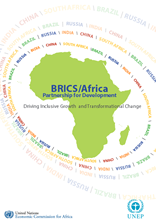BRICS/Africa Partnership for Development

Faced with energy insecurity, dwindling natural resources and pollution challenges, African countries must put in place appropriate strategies for designing future development, using suitable technologies for sustainable development. Green technologies offer Africa a chance to “leapfrog” from carbon-intensive development characterized by wasteful and unsustainable technologies and systems as used by developed countries, by directly transitioning to cleaner and renewable energy sources needed to achieve sustainable development.
Africa has limited capacity to respond to the scale and magnitude of climate change impacts and is thus the most vulnerable region in the world. The impact of climate shocks on livelihoods is exacerbated by low levels of development and widespread poverty, factors that underlie the vulnerability of local communities.For instance, more than 70 per cent of all natural disasters in the United Republic of Tanzania are linked to extreme droughts and floods, both of which are caused by climate variability. Adopting resilient approaches could enhance the performance of food systems and their key functions in contributing to food security, social welfare and ecosystem security. To effectively respond to these challenges national and regional development strategies should align with the following:
- Efforts to tap into agriculture potential in Africa
- Use of renewable energy to transform Africa
- Technology, innovation and employment opportunities for sustainable and inclusive growth
Over the last decade, South–South trade has almost doubled. Currently, BRICS (Brazil, Russia, India, China and South Africa) countries trade more with Africa than they do among themselves, with trade expected to reach more than $500 billion by 2015. Investments in Africa from China alone reached $2.3 billion in 2013. The BRICS countries have some of the leading firms in the core green economy sectors that are emerging across the world.
Africa should strive to establish partnerships with the BRICS countries to unlock potential green technology opportunities as they are quickly becoming the dominant force for innovation towards sustainable development. For instance in 2012, China added 23.1 GW of clean energy-generating capacity, while investing $65.1 billion in clean and renewable energy. There is an opportunity for Africa to capitalize on the BRICS Multilateral Cooperation Agreement on innovation that was formalized during the Sixth Summit in Brazil. The agreement aims to provide support for projects and initiatives that promote investments in technological innovation, with emphasis on infrastructure and sustainable energy, as well as innovations in processes and products in various areas of industry, services and agribusiness.
Some of the trade linkages between Africa and BRICS are:
- South-South trade offers African countries a way to benefit from their commonalities with other developing countries.
- Green technologies for renewable energy
- Remanufacturing industry in Africa
- Organic agriculture opportunities for regional cooperation and trade
- Energy efficient standards for appliances
To ensure that lessons learned from, and cooperation with the BRICS countries leads to balanced and sustainable development, it is important to deal with vexing issues. For example, sustaining the current economic growth in Africa requires a deliberate effort to align growth with structural transformation. Structural transformation in turn must be tuned towards high economic growth, jobs and wealth creation that do not undermine environmental sustainability. This must be anchored on innovations that take into account the following imperatives:
- Resource efficiency
- Adopting low carbon development strategy
- Investment as a key tool
- Building strong institutional frameworks
- Inclusiveness
Green investment and inclusive growth in Africa requires better use of natural resources guided by a combination of policies and regulations that take into consideration environmental and social concerns in development. A number of BRICS countries are transforming their development using innovations and mainstreaming sustainability into their core business practices. Africa can emulate these lessons through cooperation in human capacity development, financing, fair trade, infrastructure development and the transfer of cleaner technologies.
Fifth BRICS Summit – Two Key Agreements for Africa
- BRICS Multilateral Infrastructure Co-Financing Agreement for Africa to pave way for the establishment of co-financing arrangements for infrastructure projects across the African continent.
- BRICS Multilateral Cooperation and Co-Financing Agreement for Sustainable Development, aimed at exploring the establishment of bilateral agreements to facilitate cooperation and co-financing arrangements, specifically around sustainable development and green economy elements.
Sixth BRICS Summit – Two Key Agreements for Africa
- New Development Bank (NDB)- Intended to mobilize resources for infrastructure and sustainable development projects in BRICS and other developing economies under Article 11 of the Fortaleza Declaration
- Multilateral Cooperation Agreement on Innovation (MCAI) on support to projects that promote investments in technological innovation, infrastructure, sustainable energy and agribusiness.